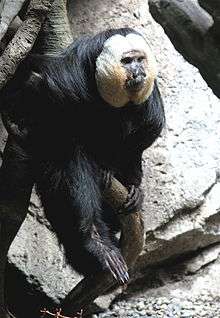Saki monkey
Sakis, or saki monkeys, are any of several New World monkeys of the genus Pithecia.[1] They are closely related to the bearded sakis of genus Chiropotes.
| Sakis | |
|---|---|
 | |
| White-faced saki (Pithecia pithecia) | |
| Scientific classification | |
| Kingdom: | Animalia |
| Phylum: | Chordata |
| Class: | Mammalia |
| Order: | Primates |
| Suborder: | Haplorhini |
| Infraorder: | Simiiformes |
| Family: | Pitheciidae |
| Subfamily: | Pitheciinae |
| Genus: | Pithecia Desmarest, 1804 |
| Type species | |
| Simia pithecia Linnaeus, 1766 | |
| Species | |
| |
Range
Sakis' range includes northern and central South America, extending from the south of Colombia, over Peru, in northern Bolivia. and into the central part of Brazil.
Body functionality
Sakis are small-sized monkeys with long, bushy tails. Their furry, rough skin is black, grey or reddish-brown in color depending upon the species. The faces of some species are naked, but their head is hooded with fur. Their bodies are adapted to life in the trees, with strong hind legs allowing them to make far jumps. Sakis reach a length of 30 to 50 cm, with a tail just as long, and weigh up to 2 kg.
Habitat and habit
Sakis are diurnal animals. They live in the trees of the rain forests and only occasionally go onto the land. They mostly move on all fours, sometimes running in an upright position on the hind legs over the branches, and sometimes jumping long distances. For sleeping they roll themselves cat-like in the branches. They are generally very shy, cautious animals.
Diet
Sakis are frugivores. Their diet consists of over 90% fruit and is supplemented by a small proportion of leaves, flowers, and insects. Sakis, as well as uakaris, engage in a specialized form of frugivory in which they focus specifically on unripe fruits and seeds.
Procreation
Mating is non-seasonal, and can happen any time during the year. After approximately 150- to 180-day gestation, females bear single young. The young are weaned after 4 months, and are fully mature in 3 years. Their life expectancy is up to 30 years.
Classification
- Genus Pithecia
- Equatorial saki, Pithecia aequatorialis (Hershkovitz, 1987)[2]
- White-footed saki or buffy saki, Pithecia albicans (Gray, 1860)[3]
- Cazuza's saki, Pithecia cazuzai Marsh, 2014[2]
- Golden-faced saki, Pithecia chrysocephala (I. Geoffroy Saint-Hilaire, 1850) Marsh, 2014[2]
- Hairy saki, Pithecia hirsuta (Spix, 1823)[2]
- Burnished saki, Pithecia inusta (Spix, 1823)[2]
- Rio Tapajós saki or Gray's bald-faced saki, Pithecia irrorata (Gray, 1842)[3]
- Isabel's saki, Pithecia isabela Marsh, 2014[2]
- Monk saki, Pithecia monachus (É. Geoffroy Saint-Hilaire, 1812)[2]
- Miller's saki, Pithecia milleri (J. A. Allen, 1914) Marsh, 2014[2]
- Mittermeier's Tapajós saki, Pithecia mittermeieri Marsh, 2014[3] (disputed)[4]
- Napo saki, Pithecia napensis (Lönnberg, 1938) Marsh, 2014[2]
- White-faced saki, Pithecia pithecia (Linnaeus, 1766)[2]
- Pissinatti’s bald-faced saki, Pithecia pissinattii Marsh, 2014[3] (disputed)[4]
- Rylands' bald-faced saki, Pithecia rylandsi Marsh, 2014[3] (disputed)[4]
- Vanzolini's bald-faced saki, Pithecia vanzolinii (Hershkovitz, 1987) Marsh, 2014 [3]
References
- Groves, C. P. (2005). "Order Primates". In Wilson, D. E.; Reeder, D. M (eds.). Mammal Species of the World: A Taxonomic and Geographic Reference (3rd ed.). Johns Hopkins University Press. pp. 147–148. ISBN 978-0-8018-8221-0. OCLC 62265494.
- Marsh, L. K. (July 2014). "A Taxonomic Revision of the Saki Monkeys, Pithecia Desmarest, 1804, Part 1" (PDF). Neotropical Primates. IUCN/SSC Primate Specialist Group, Conservation International. 21 (1): 1–82. Retrieved 2014-09-03.
- Marsh, L. K. (July 2014). "A Taxonomic Revision of the Saki Monkeys, Pithecia Desmarest, 1804, Part 2" (PDF). Neotropical Primates. IUCN/SSC Primate Specialist Group, Conservation International. 21 (1): 83–163. Retrieved 2014-09-03.
- Serrano-Villavicencio, J.E.; Murtado, C.M.; Vendramel, R.L.; Oliveira do Nascimento, F. (January 2019). "Reconsidering the taxonomy of the Pithecia irrorata species group (Primates: Pitheciidae)". Journal of Mammalogy. 100 (1): 130–141. doi:10.1093/jmammal/gyy167.
External links
![]()
| Wikimedia Commons has media related to Pithecia. |